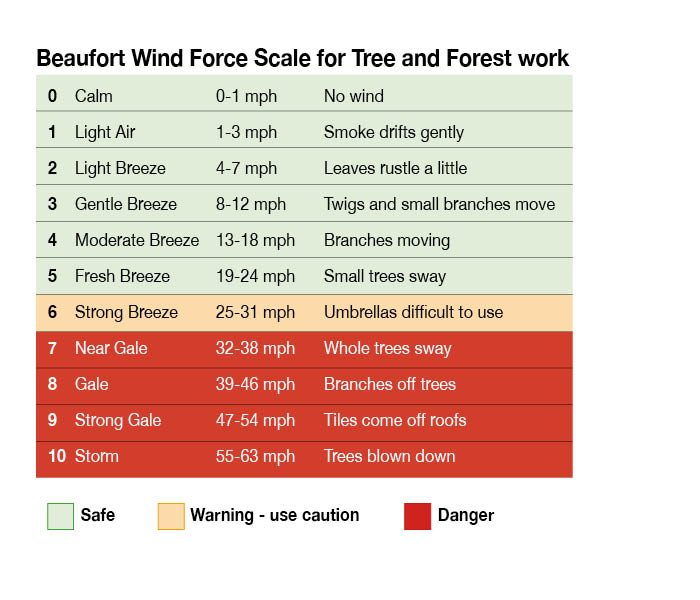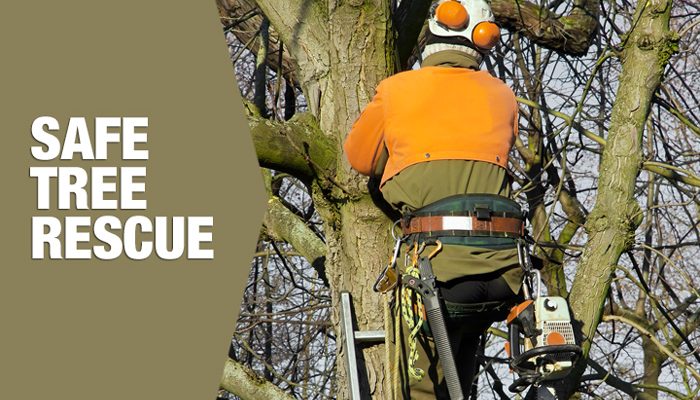
Safe rescue for Arborists
11 February 2018
Aerial Rescue from Powered Access Platforms
Even with the right equipment tree cutting at height demands safe working practices. Good climbing techniques should include the regular practice of rescue for operatives who get into difficulty. A minimum of two people must be present during tree climbing and working at height operations. At least one ground member must be competent and trained to perform a rescue from a raised platform.
Good planning is essential:
• A daily programme for the tree work should be established.
• A contact procedure established with a designated person
• Two-way radio / mobile phone communication between ground and raised platform
The Risk Assessment
As part of the pre-work risk assessment, emergency procedures for the recovery and evacuation of casualties needs to be established. All operatives and ground workers need to be trained in these procedures. When a rescue is needed, all precautions must be taken to safeguard other team members. Restrict access to trained rescue personnel only.
Before the Rescue
If overhead power cables are involved, stop work and call the relevant electricity authority.
Try and assess the condition of the casualty. If necessary call the emergency services before attempting the rescue. Help them by giving the exact location and any site access problems they may encounter. Pass on the casualty’s personal details, time of the incident and any treatment given. Notify if any chemicals have been involved.
Worksite Rescue Equipment
The minimum rescue kit that always needs to be available includes:
• First Aid kit
• Climber’s harness and associated ropes, karabiners and associated equipment
• Other climbing equipment including ladders, ropes and climbing irons
• Sharp knife with retractable blade suitable for cutting ropes. Care must be taken when cutting tensioned ropes.
During the course of the rescue assess the situation and send for more equipment as necessary.
The Casualty
• Where possible give reassurances, minimise panic but also encourage self-help
• The rescue method chosen should minimise risk to the rescuer and prevent further injury to the casualty
• If MEWPs or cranes are required for the rescue, ensure the equipment is used by trained operators only
Climbing to the Casualty
• Select a climbing method and get to the casualty as quickly and safely as possible
• If climbing equipment and trained personnel are available, use them to quickly reach the casualty
• Assess the hazards and choose appropriate tree cutting equipment to remove branches that may impede the rescue
• Make the surrounding area safe from hazards
• Assess the casualty’s condition and apply first-aid as necessary
• Take care with serious injuries such as fractures, crush or spinal injuries and only move under trained medical supervision (e.g. paramedics).
Descending with the Casualty
• The rescuer should monitor changes in the casualty’s condition and keep them calm
• The rescuer must ensure their own safety and be securely anchored at all times to enable a safe descent
• Rescuer and casualty should descend together easing movement through branches
• Densely packed branches may require an alternative rescue method
Completing the Rescue
After helping the paramedics and escorting safely from site…
• Ensure site is safe and secure
• Take names and contact details of any witnesses
• Take photos of the site
• Any equipment that is in the incident must not put back into use until it has a thorough examination by a qualified person
• Record in Accident Book and notify management
• Ensure compliance with RIDDOR requirements (Reporting of Injuries, Diseases and Dangerous Occurrences Regulations 1995)
Summary
Good planning as well as regular practice are key to safe rescue operations. An incident may not occur for years, or it could happen tomorrow. All those using powered access platforms are responsible for the safe rescue of operators and staff whenever it is required.
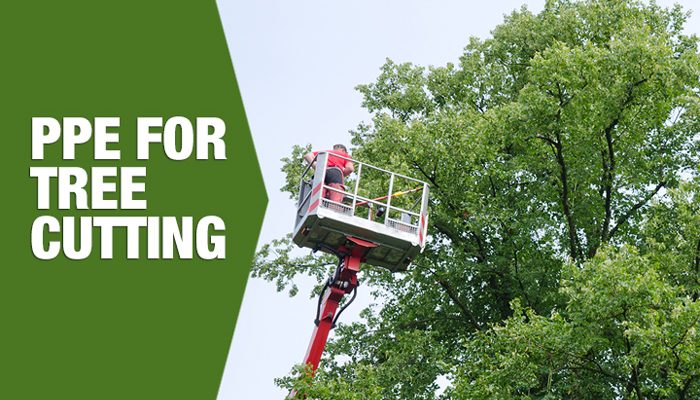
Tree Lopping Equipment
4 February 2018
Tree Lopping Equipment – Safety for arborists
Your pre-use risk assessment will determine if a spiderlift is the right equipment for tree work at height. Just as important as checking the suitability of the MEWP chosen for the task is checking the personal protective equipment (PPE) required by the operatives.
Serious accidents do occur in arboreal and forestry work. Tree work has a major incidence rate higher than the construction industry. Whether you own or hire a spiderlift, it is your responsibility to ensure staff are correctly trained and equipped.
PPE without a chainsaw
PPE for operatives using the basket but not a chainsaw should protect the head, feet, hands.
• The safety helmet should comply with BS EN 397 or BS EN 12492
• Protective boots complying with BS EN 345-1 should be worn
• Work gloves that are suitable for the task in hand
PPE with a chainsaw
Because of the inherent dangers of using a chainsaw whilst working at height, especially from flying sawdust and falling branches, protective equipment is essential. In addition to the head, feet and hands – eye, ear and leg protection are needed.
• As above the safety helmet should also comply with BS EN 397 or BS EN 12492
• Eye protection (especially from flying wood splinters) which can be either a mesh visor complying with BS EN 1731, or safety glasses to BS EN 166
• Hearing protection complying with BS EN 352
• Protective boots need to be stronger with good grip, protective guarding at the upper front and instep, and comply with BS EN ISO 20345. Look out for the chainsaw logo.
• Leg protection and groin protection complying with BS EN 381-5: Type A or C
• Appropriate gloves subject to the operator’s risk assessment
Additional PPE for all operatives
• Wear non-snag outer clothing – high visibility if justified by risk assessment
• Carry a personal first-aid kit that includes a large wound dressing
• Carry a suitable knife with a retractable blade
Summary
The wearing of Personal Protection Equipment by the tree-work gang is essential. Only trained and authorised people should operate the spiderlift. A spiderlift also requires minimum of two people to operate it and the ground staff must be able to operate the emergency controls on the platform below.
Promax Access specialise in providing high access tree cutting equipment for the Forestry industry and tree cutting services. We can offer a wealth of advice on choosing the right access platform for the job. Contact us now.
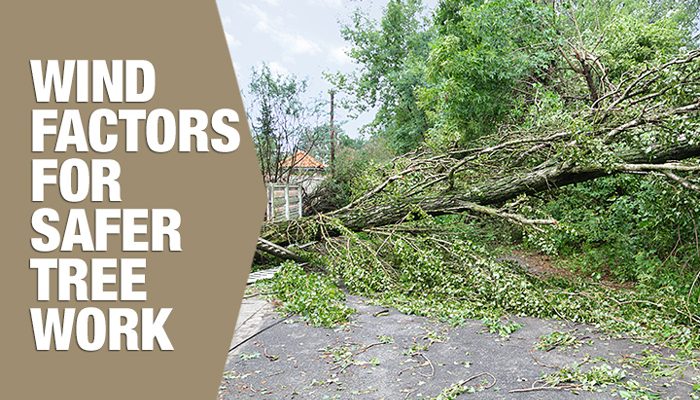
Safer Tree Work and Wind Factors
27 January 2018
Tree work with powered access platforms and the effect of the wind
Just as the sailor keeps a “weather eye” on the wind, so must the MEWP operator and workforce. As part of the pre-work risk assessment it is important not to forget the possible effects of a change in wind speed. This is particularly so for those offering tree work.
A powered Spiderlift access platform that works outside will operate up to a maximum wind speed that will have a mark on the machine or available in the hand manual. Operation above the maximum wind speed could cause instability and affect the safety of both operator and those below. As a guide, wind speeds above 28mph pose a safety risk making it uncomfortable and dangerous for the operator to continue to work.
Other Wind Factors During Tree Work
Other wind factors may also increase the risk of accidents during tree work. Wind chill has a serious impact on the ability to work safely at height. On a cool calm day with a temperature of 10 degrees C, it may feel comfortable enough. However, when the wind rises to 20mph the effect on the hands and face is to lower it to 0 degrees! If work was to begin at 0 degrees C on the ground and the wind become to rise to 20mph, then the effect on the skin comes -15 degrees C. Obviously it is important to wear very warm clothing at such temperatures.
It should always be remembered that wind speed increases with height. At 20 metres above ground it could increase by 50%. The recommendation is that operators carry with them a hand held anemometer that they can quickly check at platform level. This essential piece of arborist equipment is available for less than £10 and measures wind speed, wind gust, wind chill and temperature. The anemometer comes with a lanyard for all powered access platform operators.
The Beaufort Wind Force Scale
This wind force scale was devised at the beginning of the 19th century. It is still useful today as it is based on visual and subjective observation. The normal scale ranges from zero to 10. Working at height on at the scale of zero to 5 is considered safe. However at Level 6 – Strong Breeze – opertaters will be more cautious. Wind speed at this level ranges from 25 to 31 mph. The “safe” speed of 28 mph can easily move into a dangerous situation. All tree work at levels above Level 6 is completely unsafe.
Summary
Always include wind speed in the pre-start risk assessment and monitor throughout the progress of the tree service when using forestry access platforms. The hand held anemometer is a cheap practical tool for tree work when operating in the raised basket. A quick check will reduce the risk of instability and highlight freezing “wind chill” conditions.
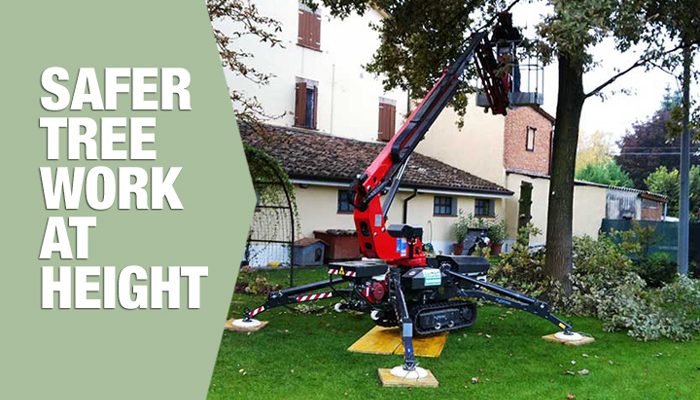
Tree Cutting Equipment
21 January 2018
Powered access platforms – the safe choice for tree cutting equipment
The value of trees to our environment is high on the agenda in managing our atmosphere. Often referred to as “the lungs of the planet” they absorb carbon dioxide and release oxygen; they stabilise soil by absorbing water; and provide a home for our wildlife.
Careful management of this vital resource relies on expert tree surgeons and their tree cutting equipment. Some work can be done at ground level but much is done at height. As with all working at height, risks are involved and need to be carefully managed.
The traditional climbing gear for arborists consists of ropes and ladders, these however carry considerable risks for the user. A much safer way to reduce the likelihood of an accident is by using a powered access platform. A “spider” platform is the perfect addition to any arborists tree cutting equipment.
The HSE and The Arboricultural Association have both published guides and a code of practice for a safer working environment when working at height with trees. The key element is a risk framework that is properly planned, appropriately supervised and carried out in a safe manner.
Roles and responsibilities should be clearly identified in risk management and planning. Tree key personnel need to be identified –
• Responsible Person – who determines a generic assessment and risk control procedures which are largely unchanging from site to site
• Competent person – who appraises specific on-site risks including emergency procedures and protocol
• Proficient operator – conduct the on-site appraisal on the day of working, validating and applying the safe systems of work identified by the competent person.
Both the HSE and the Arboricultural Association highlight that before any tree work operations begin, a risk assessment must be made. They identify that using tree service equipment platforms, such as a Spider platform, lowers the risk of accident when compared with rope and ladder.
The risk assessment will include a pre-work evaluation as to whether tree work at height is appropriate; a check that safe systems are in place; that operators are properly trained; identification of site-specific hazards; an emergency plan is in operation; and that everyone concerned has a clear idea of the tasks to be completed.
There are two important concerns specifically for powered access platform operators:
• Individuals should identify the drop zone
• They should use appropriate and accurate cutting techniques
Power access platforms are quicker and safer for arborists and are the perfect tree service equipment operating with versatility and flexibility in challenging locations. As with all work at height, a pre-work Risk Assessment is essential for the safety of all.
Promax Access specialise in providing high access tree cutting equipment for the Forestry industry and can offer a wealth of advice on choosing the right access platform for the job. Contact us now.

MEWP Rescue Planning
14 January 2018
IT’S DOUBTFUL that the poet Robert Burns had a powered access platform in mind when he wrote “To a Mouse”. However, it is to the great Scottish Bard himself that we owe the phrase: “The best-laid plans of mice and men often go awry”. He wrote the poem after rescuing a mouse nest he had accidentally ploughed up. The observation is timeless and applies to all: No matter how a project is planned, accidents can happen.
It’s also doubtful when MEWP rescue planning that the plight of a mouse will spring to mind. But perhaps what should, is a rescue plan in case the unexpected should happen. Not for a mouse of course, but for MEWP operators and workforce.
As mentioned before, carrying out a detailed and thorough risk assessment of the job location will identify most of the potential hazards before the job starts, but sometimes human error or acts of nature, such as fast changing or extreme weather conditions, can mean that things still go wrong. It is important to have a rescue plan in place to support and assist the workforce in case of an accident or mechanical failure.
MEWP Rescue Planning
Most forestry access equipment has back-up systems built into the machine which enable the operator to return the raised platform back to ground level. Though these systems rarely fail it can still happen so it is vital to have a plan for how people can be brought down safely.
Any MEWP rescue planning should comply with current health and safety legislation such as the 2005 Work at Height Regulations. It is important to do a risk assessment for the rescue and keep a record of this assessment and all details of the rescue as this may be important to refer to at a later date.
In the event of a rescue being required:
• Activate all normal emergency lowering procedures if possible
• Contact the manager of the site or project to report any failure of back-up emergency systems
• Get the powered access platform checked by a qualified engineer to see if an on-site repair can be carried out
Basket-to-basket rescue
If it is not possible to repair the lowering mechanisms then a basket-to- basket rescue may be necessary. This can be complicated and poses additional health and safety risks so it is important to follow the following steps:
• The rescue machine should be placed in the safest position to minimise any additional danger to anyone involved in the rescue
• Place the two machines adjacent to each other with the smallest possible gap between them
• Attach a double lanyard to both the person being rescued and the anchor points on both machines before the rescue takes place
• Never overload the rescue machine as this could lead to over-tipping or delay the rescue operation
In exceptional circumstances, where a basket-to-basket rescue is not feasible, emergency evacuation systems such as a crane rescue could be used.
Summary
Having a rescue plan is an essential part of planning a job and, though access equipment is safe and efficient, there are rare occasions when jobs don’t go to plan. Carry out a full risk assessment, keep a record of any rescue situation as it happens, and try the simplest solution first before attempting a more complicated rescue procedure and the situation can be resolved quickly and carefully.

MEWPs. Be extra careful in winter!
7 January 2018
Don’t get complacent in fast changing weather conditions.
The mid-winter weather in the UK is always volatile. Conditions can change from sunshine to sleet and snow showers in a few hours. Conditions may be fine when starting a powered access platform job on a chilly but pleasant morning, but by lunchtime, they can quickly become treacherous.
Winter MEWPS are not only designed to be safe and fully functional in bad winter weather but working in quickly changing conditions can increase the health and safety risks for workers and create additional access problems.
Whether you are onsite or offsite, working at height requires a suitable risk assessment to avoid potential dangers. However, fast changing weather may require constant monitoring of the initial risk assessment.
What was good at 8.00am may not be the same after lunch.
Carrying out a risk assessment does not need to be overly complicated but it does need to be an important part of planning and completing a job. Both the supervisors and the staff should be aware of the potential dangers so they can actively avoid them.
The HSE website provides full and detailed advice on planning and completing a risk assessment for a wide range of jobs but here are the five main points to consider:
• Identify the Hazards – Walk round the site and make observations. Some of these may be obvious but it is worth getting a second opinion in case there is something you haven’t noticed.
• Decide who might be harmed and how – It may be a job onsite or there may be safety concerns for the general public. Make sure staff are adequately trained to complete the work and briefed on the requirements of the job.
• Evaluate the risks and decide on precautions – Avoid working at height where it is reasonably practicable to do so, for example can you get equipment or materials prepped at ground level?
• Record your findings and implement them – Check the maintenance of the powered access platform and other equipment and make sure that workers know how to operate it safely and effectively. Take extra steps to prevent any person falling a distance that could cause personal injury and use equipment to minimise the distance and consequences of a fall if necessary, such as safety nets.
• Review your assessment and update if necessary, not just at the start of a job, but hourly if necessary. Circumstances change all the time so your assessment of the risks will too.
Summary
Powered access platforms make working at height safer and quicker but they do not remove all the potential risks that changeable bad weather can bring. Constant monitoring of the risks will ensure that potential problems are managed and be prevented. Each job is different but the aim is the same: complete it without an incident or injury.
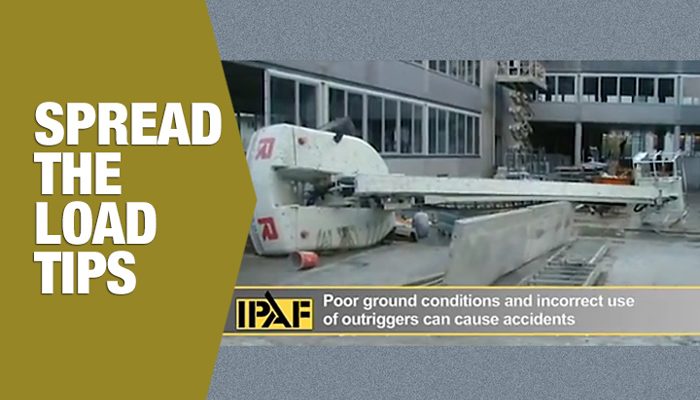
Safer MEWP use
31 December 2017
The importance of spreader plates
The use of spreader plates with boom lifts and outriggers can save lives and minimise the risks of overturning and instability. The IPAF ‘Spread the Load!’ campaign aims to encourage the use of spreader plates with powered access platforms and prevent accidents that are caused by inadequate risk assessments of unstable ground and incorrect set up of access equipment.
Why use spreader plates?
Spreader plates reduce the heavy loads and pressure at the point of contact between a boom lift or stabilizer leg and the ground, by spreading the load through a wider area.
When they are not used, the pressure can cause problems, even on seemingly stable ground surfaces, including instability, sinking or tipping over all of which can lead to serious injury and even death.
This short four minute IPAF video demonstrates how using spreader plates reduces the risk of overturning.
A typical 18m boom can weigh more than 10 tonnes and generate a ground bearing pressure more than 14.06kg/cm. If the spreader plate is just twice the size of the outrigger foot, it can reduce the ground pressure by four times.
Risk assessments for jobs at height need to consider ground conditions and potential issues below the surface such as services. However, it can be hard to tell how solid the ground is as conditions can change with the weather and can vary even on the same site.
Choosing the right spreader plates
Selecting the right size and type of spreader plate for specific locations and access equipment is important. Spreader plates should be big enough, stiff enough and strong enough to cope with the pressure and weight demands.
The following points should be considered before the job starts:
• Identify poor ground conditions, assess the load bearing pressure of the ground and calculate the correct size of spreader for the situation
• Plate size should reduce load-bearing pressure and provide a stable footing and not sink into the ground when in use
• They should be stiff enough to create high pressure points and not sink or distort
• Plates should be strong enough to bear the load without breaking
• The plates can be made from timber, aluminium or various plastics and resins.
• Varied ground and weather conditions mean even jobs on the same site may need different plates.
Summary
In most conditions, MEWPs are very safe and stable. However, instability and overturning may result from inadequate ground assessment, poor selection of spreader plates, or incorrect positioning of outriggers. Choosing the right spreader plates can significantly reduce the risk of accidents.
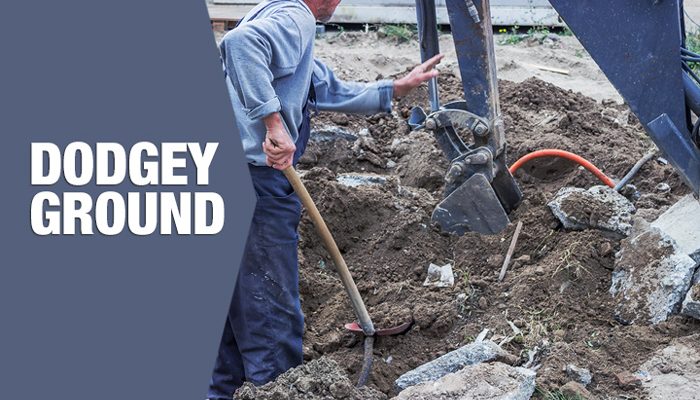
High Access MEWP Stability
24 December 2017
Tips to avoid costly accidents
Whilst power access platforms are designed to be strong and stable on a wide range of floors and spaces, whether on or offsite, the most common type of accident involving powered access platforms is still overturning. With due care and attention these dangerous and expensive incidents may be avoided. There are two main factors which can prevent stability problems: a basic understanding of stabilising equipment properly and carefully assessing the surface they are used on.
High Access MEWP Stability
Powered access platforms use various methods to stabilise on uneven ground – some spider lifts have adjustable legs that can be set up in different positions and on different levels and all-terrain vehicles can be set up on severely sloping gradients. Here are some key points to remember:
• Each machine has benefits and limitations so familiarise yourself with the specifics and only operate the machine within the manufacturer’s recommendations
• Inspect the machinery to make sure it is fit for use and ensure operators are fully trained
• Warning lights on the control panel will tell the operator if the machine is not level
• Outriggers generate high pressure at the feet which may not be supported by many areas of soil or unmade ground and even some paved areas, so additional foundations may be required
Checking the Ground
Ground conditions have a big impact on the stability of MEWPs and a ground survey should be completed before every job. The ground may settle when subjected to the loads of MEWP wheels or outriggers. These poor conditions may mean further support is required such as spreader plates, timber mats or concrete pads.
Ground condition assessment is also important for self propelled MWEPs such as booms and scissor lifts which may be driven along the ground with the platform raised. Moving from hard ground to soft may cause instability and overturn.
Level indicators provided on the MEWPs should be constantly monitored by the operator. If warnings are given when safe operating limits are exceeded, the platform should be lowered and the MEWP reset in a level position.
Spider platforms with outriggers should also be regularly checked for machine level especially if suspected that spreaders or mats may be sinking.
Potential Ground Condition Hazards
Prior to using a high access MEWP a visual inspection and assessment of ground conditions are often adequate (as opposed to having a full geotechnical survey). This assessment must be made by a person with the knowledge and experience to know if further expert advice is needed.
When checking the ground look out for these typical hazards…
• Uncompacted Fill – look for backfilled trenches and any cracking along the line of the trench
• Proximity to Excavations – If the MEWP needs to be used close to the edge of trenches or excavations where the outriggers or wheels may be in the “danger area”, then an engineering assessment must be made by a competent geotechnical engineer before the MEWP is set up and operated.
• Floors, Cellars, and Basements – Check the load bearing. Many floors are unable to take the weight of a MEWP and could collapse without warning. If in doubt get a geotechnical engineering assessment made.
• Paved Areas – May look strong but could have been laid on weak ground. Look for cracks and uneven slabs. Footpaths should be considered suspect and carefully checked.
• Underground Services – The weight of a MEWP may cause damage to sewers, drains, manholes and gas and water mains. Use caution.
• Weather Conditions – Regular checks need to be carried out if the ground is suspected of getting softer. Heavy rain and frozen ground thawing out can have adverse effects on MEWP stability.
Summary
MEWPs can be stabilised and perform safely and effectively on most surfaces and gradients provided a few basic things are taken into consideration. Get familiar with the machine’s warning devices and what it is capable of doing. Assess the ground conditions that you are working on to ensure you can use the machine to its optimum performance to help prevent avoidable stability accidents.
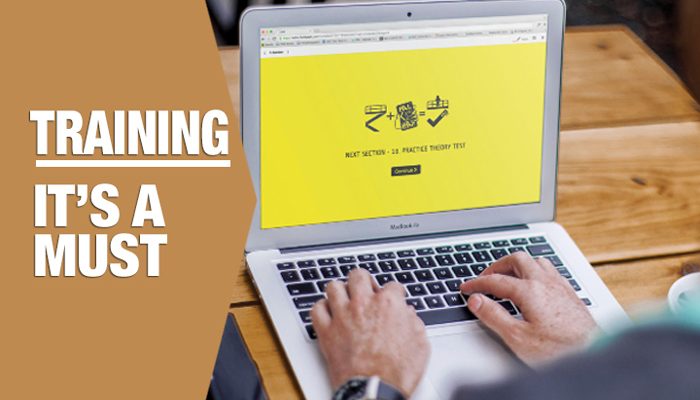
Training on MEWPs
17 December 2017
Review your Training on MEWPs
With the new year coming up soon. now is a good time to reflect on the past year and your training program for using powered access platforms. Both employers and individual users are liable if the people in charge of the machinery are not properly trained. Training on MEWPs can make working at height safer, quicker and more efficient but it should be remembered that operators need a PAL card and this needs to be renewed every 5 years. Are all log books up to date? Is a refresher course needed?
If your future job plans mean working in higher risk or challenging environments your operators may need a PAL+ card. Special training is available, for example, for working in confined overhead spaces or on challenging terrain.
There are courses for managers who are responsible for planning, supervising and effectively managing the use of powered access equipment. This is not about operating the machines per se, it’s about health and safety regulations, accident prevention and control, protective equipment and pre-use checks and maintenance schedules.
All levels of management would benefit from this type of training. This includes project managers, foremen and supervisors working in a broad range of industries such as construction, facilities management, retail, airports and arboriculture.
Who needs training on MEWPs?
Employers and individual users must make sure operators are properly trained. Rental companies are also obliged to direct their clients to appropriate training if they don’t deliver it themselves.
Courses are available for:
• Operators
• Demonstrators
• Instructors
• Managers
Accredited training centres are located across the country and courses can be held at their premises, or on a convenient site with suitable facilities.
What’s involved?
Training on MEWPs is a combination of classroom based study and hands-on experience with the equipment and includes:
• industry regulations and standards
• Choosing the right platform for the job
• Carrying out workplace inspections
• Operation of the powered access platform including demonstrated proficiency in all functions of the equipment
• How to recognise and avoid common hazards
• Operator warnings and instructions
• The purpose and use of manuals
• Carrying out a pre-start inspection
• Factors affecting stability
• Personal protective equipment
• General equipment components
• Safe use of equipment
• Understanding issues associated with larger machines: e.g. outriggers/stabilizers, extendable axles and envelope management systems.
New online eLearning Training
IPAF the aerial work platform industry professionals have recently developed an online eLearning training course for operators.
This new enhanced eLearning module is part of IPAF’s full training programme for operators of mobile elevating work platforms (MEWPs). The eLearning module delivers flexibility and interactive tools, with the same emphasis on practical training. Operator eLearning does not replace practical training. Trainees who complete the online session must still pass a supervised theory test at an IPAF approved training centre and must successfully complete a minimum half-day of practical training and testing.
Summary
Powered access platforms have many benefits for working at height but there is a legal obligation to make sure they are used safely and properly. Training staff is not only a legal requirement but jobs can be completed more efficiently if everyone involved knows how to use the equipment properly and dangerous and costly accidents are avoided.
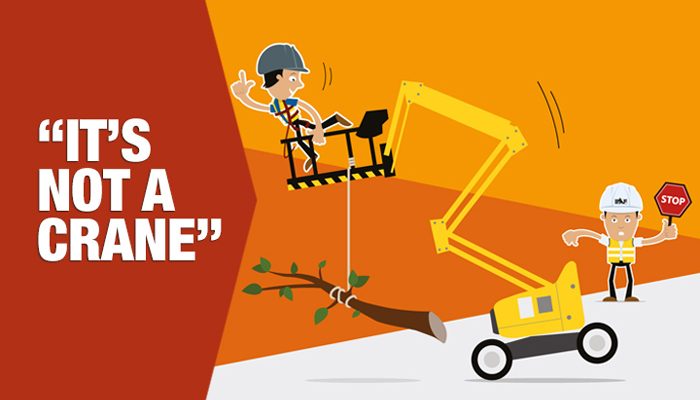
It’s not a Crane!
10 December 2017
IT’S A MEWP – NOT A CRANE!
Using MEWPs for working at height is one of the safest ways to reach those elevated areas to get vital work done. At this time of year power access platforms are doing their bit to bring festive cheer to brighten our day. Public spaces, malls and shops all rely on MEWPs to get the Christmas trees, decorations and lights in place all adding to the Season’s cheer.
Although the fatal injury rate for power access platforms is declining, there were still 66 reported MEWP fatalities in 2016. The main causes were falls from height, electrocution, entrapment and overturn of machinery. Chris Wraith, IPAF’s Safety & Technical Executive, commented: “While it is heartening to see the effective fatal injury rate fall … we must not be complacent. It is disappointing to see the same main causes of fatalities being repeated year on year, which suggests that the industry as a whole is not learning the lessons from previous incidents. Investigations show that accidents are most often due to management failings or operator error, which can in almost all cases be anticipated and avoided, or at least mitigated.”
The IPAF accident reporting project has identified a number of valuable learning outcomes and as a result, are reinforcing the key messages with a series of posters featuring the characters “Andy Access” and “Hugh Hazard”. These are available from www.ipaf.org/AndyAccess.
Using a MEWP as a crane may seem a quick, convenient idea but it is highly dangerous. As the IPAF poster reiterates “MEWPs are designed to elevate people, tools and equipment inside the work platform”. Using powered access platforms as a crane can easily tip the platform over creating a danger both for the occupant and those on the ground.
THE RIGHT EQUIPMENT FOR THE JOB
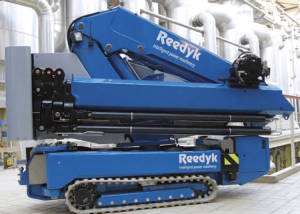
The compact crane and a compact powered access platform are the perfect partners to safely tackle those difficult to reach places where access is restricted. Choosing the right equipment for the job, proper training and good risk assessment are essential to help reduce accidents in the industry.
